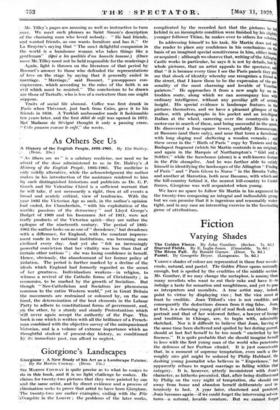Giorgione's Landscapes
Giorgione : A New Study of his Art as a Landscape Painter. By Sir Martin (Bann. 15s.)
SLR MARTIN CoNwAV is qiiite precise as to what he essays to tic in this book, and it is no light chAllenge he makes.. He Aiiims for twenty-two pictures that they were painted by one and the same artist, and by direct evidence and a process of .elimination seeks to prove that artist to have been Giorgione. The twenty-two are earlier - examples-, ending with the Fete .7-ilanpitre in the Louvre ; the problems of the later works, complicated by the recorded fact that the pictures he lea behind in an incomplete condition were finished by his slight), younger follower Titian, he makes over to others for solution..
In addressing himself to his task, Sir Martin does not ask the reader to place any confidence in his conclusions on the basis of an imagined special sensitiveness in him, either innate or acquired ; although we observe that, writing of the Ailing% Castle works in particular, he says it is not by details, but by whole pictures, that an artist appeals to the spectator, ani that it is because every time I see the Paris panels they gist me that shock of identity whereby one recognizes a friend on the street, that I know them to be the expression of the per. sonality of the most charming and lovable of Venetian painters." He approaches it from a new angle by an un trodden route, along which we can accompany him with ordinary intelligence, without any peculiar gift of artistic insight. His special evidence is landscape features in the pictures themselves, and we have a pleasant glimpse of the author, with photographs in his pocket and an intelligent Italian at the wheel, careering over the countryside in motor-car in search of these, and being successful in the quest. He discovered a four-square tower, probably Romanesque, at Bassano (and there only), and near that town a farmhouse with long sloping roof sheltering a wooden veranda ; and these occur in the " Birth of Paris " copy by Terriers and the Budapest fragment (which Sir Martin contends is an original), and again in the Marquis of Northampton's " Girl and a Soldier," while the farmhouse (alone) is a well-known feature in the Fete ehampitre. And he was further able to satisfy himself in identifying the landscapes of the Allington " Finding of Paris " and " Paris Given to Nurse " in the Brenta Valley, and another at Marostiea, both near Bassano, with which and the hill-country behind it, the nearest hill-country to Castel. franco, Giorgione was well acquainted when young.
We have no space to follow Sir Martin in his argument for the twenty-two composing an integral and indissoluble group, but we can promise that it is ingenious and reasonably water- tight, and in any case an interesting exercise in the fascinating game of attributions.










































 Previous page
Previous page